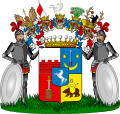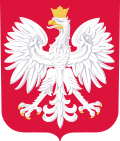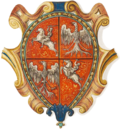| Bończa | |
|---|---|
 | |
| Battle cry | Bończa, Genorozecz, Jednorożec |
| Alternative name(s) | Bończe, Buńcza, Buńcze, Jednorożec, Rinocerus, Unicornus |
| Earliest mention | 14th century |
| Families | 212 names Babinowski, Babiński, Badeni, Badowski, Baniewicz, Bańkowski, Barszczewski, Bartoszewski, Bartoszyński, Bartynowski, Barwikowski, Bernat, Białobrzeski, Bieroński, Biniewicz, Bochdan, Bogdziewicz, Boguniewski, Bohdan, Bohdanowicz, Bohdewicz, Bojarski, Bonecki, Bonicki, Boniecki, Bonkiewicz, Bońko, Borodzic, Borodzicz, Braciejewski, Braciejowski, Brozicki, Brujewicz, Brzeski, Brzostowski, Brzyski, Bukowski, Burkovskiy, Bukszewski, Burnecki, Buza, Bystrzycki, Chalecki, Charchowski, Charlęski, Chilarski, Chmielecki, Chobotkowski, Chodnowski, Chodosowski, Chomętowski, Chrapek, Chrościchowski, Chrościechowski, Chrościejowski, Chrościkowski, Chruścikowski, Chyliński, Cichosz, Czyżykowski, Dalanowski, Domagalski, Dryliński, Dygulski, Fink, Fox, Franceson, Fredro, Gaczkowski, Gasparski, Gawski, Godkowski, Godlewski, Godzimierski, Golian, Gołaszewski, Gottartowski, Gozimirski, Grochowski, Gulbiński, Guliński, Iżycki, Jabłoński, Jacimierski, Jacimirski, Jodłowski, Kargowski, Kierski, Klonowski, Kłoda, Krajow, Krakowiecki, Kraków, Krzeski, Krzewski, Kulwiński, Kułacki, Kunicki, Linczowski, Lisowski, Lissowski, Lubecki, Lubkowski, Łokuciejewski, Łokuciewski, Łubkowski, Łubkowski Buża, Markowicz, Markowski, Miaskowski, Mieczkowski, Mierzb, Mikułowski, Milewski, Modzelewski, Moraniecki, Nagórny, Niebrzegowski, Niedabylski, Niedobylski (Nedobylsky), Olenikow, Olfinier, Osmolski, Osmołowski, Osmólski, Osmulski, Ottenhausen, Ozdowski, Parchwic, Parznicki, Pawulski, Pencuła, Pieczyński, Pióro, Płończyk, Pokrzywnicki, Postrucki, Postruski, Postruski, Prachwicz, Prawidlnicki, Przywiński, Radawiecki, Ratowt, Romanczenko, Romanowski, Rudziewicki, Ruszkowski, Rutkowski, Rybczewski, Rybczowski, Sienicki, Skaczewski, Skarzyński, Skarżyński, Skoczewski, Skokowski, Skorowski, Skronowski, Skrzydlewski, Skrzynecki, Skwarski, Socha, Solikowski, Srzebiecki, Stępiński, Stogniew, Strzebiecki, Strzebieliński, Strzelbicki, Strzeszkowski, Swaraczewski, Szablowski, Szabłowski, Szarewicz, Szerszeński, Szerzeński, Szerzyński, Szuszkowski, Szyskowski, Szyszyłowicz, Śmietanka, Tabiszewski, Tomaszewski, Tomaszowski, Tomaszowski, Toroszowski, Trebecki, Trębecki, Troszczel, Trościel, Truszkowski, Turno, Turobojski, Turoboyski, Uszdowski, Uzdowski, Waśniewski, Waśnioski, Wąsocki, Wąsoski, Wielgowic, Wilga, Wilgierd, Wyspiański, Zachert, Zawerski, Zdrojkowski, Zdroykowski, Zimnoch, Zrebiecki, Zrzebiecki, Źrebiecki, Żółkiewski, Żrebiecki Contents |
Bończa is a Polish coat of arms.




